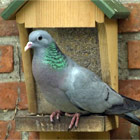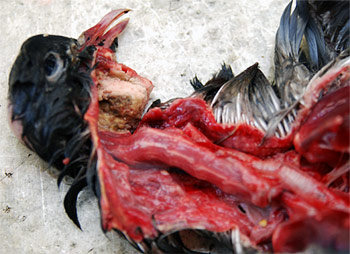Trichomonas infection in a stock dove

Photo: W. van Kruijsbergen, Saxifraga
In May 2010 a dead adult male stock dove (Columba oenas) was found in the Dutch town of Hilversum and the fresh cadaver was submitted to the DWHC for post-mortem investigation.
Macroscopic findings
The bird had a poor nutritional condition with few fat reserves and poor muscling. The skin and subcutaneous tissue of the neck were red and a lump of approximately 20x15mm was present in the throat region. On cut surface the lump was yellowy-brown and layered; similar material was found on several small lesions in the mouth. The beginning of the intestinal tract was empty and the rest contained yellowy-green material.

The neck of the dove with skin reflected; note the yellowy-brown dead tissue in the throat area.
(Photo: L. Begeman, DWHC)
Microscopic findings
Cytology: An impression smear from the lesion in the throat contained bacteria and trichomonas parasites. The feces contained large numbers of oocysts (parasite eggs).
Histology: An extensive area of the crop mucosa was dead (necrotic) with infiltration of inflammatory cells and presence of trichomonas parasites. The liver was bloody (congested) and contained a large number of iron-containing cells (Kupffers cells, which are responsible for clearing up bacteria and damaged tissue). In addition, there was variability in the size of hepatocytes and inflammatory cells were seen. The brain and lungs were also congested and the lungs contained dust (anthracose).
Laboratory testing
The presence of Trichomonas gallinae was confirmed by PCR testing performed in DWHC labs [1].
Conclusion
The lesion in the mouth and throat caused by infection with T. gallinae is likely to have led to difficulties with eating resulting in weight loss and ultimately the death of this bird.
References
- Kleina P, Bettim-Bandinelli J, Bonatto SL, Benchimol M, Bogo MR: Molecular phylogeny of Trichomonadidae family inferred from ITS-1, 5.8S rRNA and ITS-2 sequences. Int J Parasitol 2004, 34(8):963-970.
- Stabler RM: Trichomonas gallinae:a review. Exp Parasitol 1954, 3(4):368-402.
- Sansano-Maestre J, Garijo-Toledo MM, Gomez-Munoz MT: Prevalence and genotyping of Trichomonas gallinae in pigeons and birds of prey. Avian Pathol 2009, 38(3):201-207.
- Matthews RS, Daly JJ: Trichomonas gallinae: use of solid medium to test survival under various environmental conditions. Exp Parasitol 1974, 36(2):288-298.
- Forzan MJ, Vanderstichel R, Melekhovets YF, McBurney S: Trichomoniasis in finches from the Canadian Maritime provinces–An emerging disease. Can Vet J 2010, 51(4):391-396.
- Neimanis AS, Handeland K, Isomursu M, Agren E, Mattsson R, Hamnes IS, Bergsjo B, Hirvela-Koski V: First report of epizootic trichomoniasis in wild finches (family Fringillidae) in southern Fennoscandia. Avian Dis 2010, 54(1):136-141.
- Real J, Manosa S, Munoz E: Trichomoniasis in a Bonelli’s eagle population in Spain. J Wildl Dis 2000, 36(1):64-70.
- Krone O, Altenkamp R, Kenntner N: Prevalence of Trichomonas gallinae in northern goshawks from the Berlin area of northeastern Germany. J Wildl Dis 2005, 41(2):304-309.
- Anderson NL, Grahn RA, Van Hoosear K, Bondurant RH: Studies of trichomonad protozoa in free ranging songbirds: prevalence of Trichomonas gallinae in house finches (Carpodacus mexicanus) and corvids and a novel trichomonad in mockingbirds (Mimus polyglottos). Vet Parasitol 2009, 161(3-4):178-186.
- Willoughby DH, Bickford AA, Charlton BR, Cooper GL: Esophageal trichomoniasis in chickens. Avian Dis 1995, 39(4):919-924.
- Robinson RA, Lawson B, Toms MP, Peck KM, Kirkwood JK, Chantrey J, Clatworthy IR, Evans AD, Hughes LA, Hutchinson OC, John SK, Pennycott TW, Perkins MW, Rowley PS, Simpson VR, Tyler KM, Cunningham AA: Emerging infectious disease leads to rapid population declines of common British birds. PLoS One 2010, 5(8):e12215.
- Taylor MA, Coop RL, Wall RL: Veterinary Parasitology: 3rd ed. ed. Blackwell; 2007.
- Lawson B, Robinson RA, Neimanis A, Handeland K, Isomursu M, Agren EO, Hamnes IS, Tyler KM, Chantrey J, Hughes LA, Pennycott TW, Simpson VR, John SK, Peck KM, Toms MP, Bennett M, Kirkwood JK, Cunningham AA: Evidence of spread of the emerging infectious disease, finch trichomonosis, by migrating birds. Ecohealth 2011, 8(2):143-153.
- Lawson B, Cunningham AA, Chantrey J, Hughes LA, John SK, Bunbury N, Bell DJ, Tyler KM: A clonal strain of Trichomonas gallinae is the aetiologic agent of an emerging avian epidemic disease. Infect Genet Evol 2011, 11(7):1638-1645.
- Merck & Co Editor Cynthia M. Kahn: Merck Veterinary Manual. 10th ed. N.J.: Whitehouse Station, N.J., Merck & Co Editor: Kahn, C.M.; 2010.



